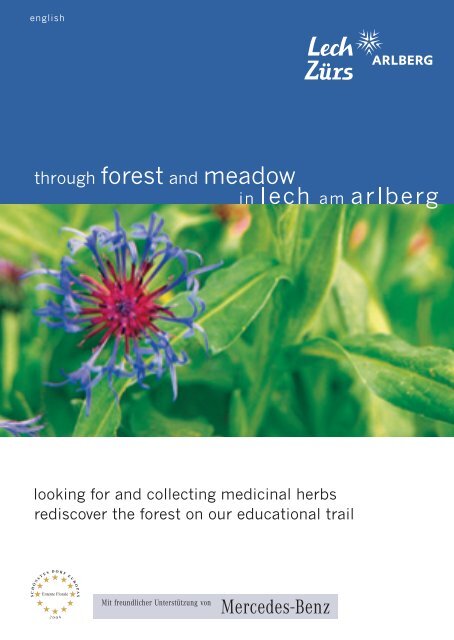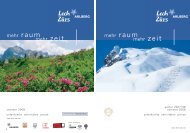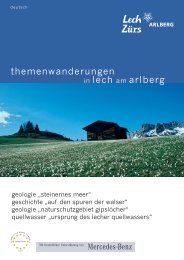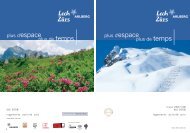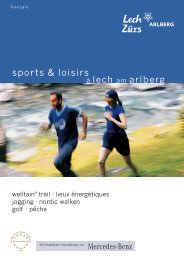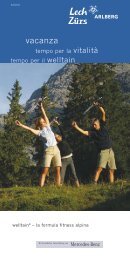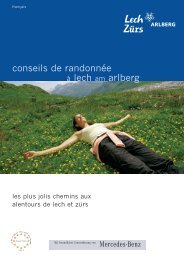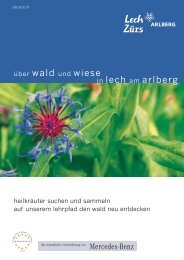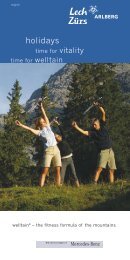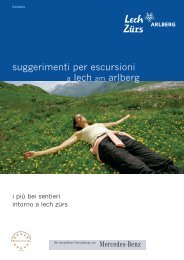through forest and meadow
through forest and meadow
through forest and meadow
Create successful ePaper yourself
Turn your PDF publications into a flip-book with our unique Google optimized e-Paper software.
english<br />
<strong>through</strong> <strong>forest</strong> <strong>and</strong> <strong>meadow</strong><br />
looking for <strong>and</strong> collecting medicinal herbs<br />
rediscover the <strong>forest</strong> on our educational trail
Information:<br />
Lech Zürs Tourismus GmbH<br />
A-6764 Lech am Arlberg<br />
Tel. 0043/5583/2161-0, Fax 0043/5583/3155<br />
Email: info@lech-zuers.at, www.lech-zuers.at<br />
Georg Schnell, Tel. 0043/5583/2617<br />
Imprint:<br />
Publisher: Lech Zürs Tourismus GmbH<br />
Photography: Georg Schnell <strong>and</strong> Rupert Pöttinger<br />
Text: Rupert Pöttinger – 6714 Nüziders<br />
Georg Schnell – 6764 Lech<br />
Arnica <strong>meadow</strong> against<br />
the “Mohnenfluh”<br />
Mountain ash at<br />
the “Spullersee”
our medicinal plants are a gift of nature!<br />
More <strong>and</strong> more people are using their healing powers to do something<br />
for their health – <strong>and</strong> rightly so, because medicinal plants<br />
work naturally <strong>and</strong> have almost no side-effects. Nowadays, medicinal<br />
plants are used successfully in everyday medicine – as teas, tinctures<br />
<strong>and</strong> special medications made from single active ingredients.<br />
They can support the healing process of various illnesses, alleviate<br />
complaints <strong>and</strong> work with a preventive effect.<br />
However, the use of this little herb compendium only makes sense<br />
if you are completely familiar with the plants <strong>and</strong> are also aware of<br />
the possibilities <strong>and</strong> limits of using them.
collecting<br />
● Anyone who collects their own medicinal herbs takes on a serious<br />
responsibility, as a lack of knowledge can result in confusion - possibly<br />
even with poisonous plants! (In case of doubt, please obtain<br />
herbs from a pharmacy).<br />
● The best time to go collecting is in the morning when the sun is shining,<br />
never when it is raining or damp.<br />
● Do not pick any dirty plants or those growing at the roadside, as<br />
medicinal herbs must never be washed!<br />
● Protect nature:<br />
– Avoid depletion by taking only as many plants as you need, <strong>and</strong> no<br />
more than required for one year.<br />
– Use scissors when collecting, to avoid ripping out the roots.<br />
– Do not collect any protected plants! (Visit a pharmacy instead)<br />
– Tread carefully <strong>through</strong> <strong>meadow</strong>s, <strong>and</strong> do not trample them to pieces.<br />
Collecting in open nature already has a „medicinal effect“, but please<br />
remember that all herbs are available in top quality from your pharmacy.<br />
drying<br />
● Immediately after the harvest.<br />
● Quickly <strong>and</strong> protectively.<br />
● In a shady, well-ventilated place, ideally on a sifting screen or hung<br />
in bundles.
storage<br />
● Ideally in a well-sealed <strong>and</strong> tinted glass jar.<br />
● Remember to add a label <strong>and</strong> the date of collection.<br />
● Do not store for longer than one year, as older plants lose their efficacy.<br />
preparation<br />
● Rule for making tea: pour 1/4 litres of boiling water over 1 – 2 tea -<br />
spoons of herbs; allow to infuse for 10 minutes.<br />
● Prepare mixtures in equal parts.<br />
● Roots: bring 1 teaspoon with 1/4 litre of water to the boil <strong>and</strong> allow<br />
to infuse for 10 minutes.<br />
… <strong>and</strong> remember<br />
● Also use medicinal herbs when you are feeling well: prevention is the<br />
best cure.<br />
● No one herb is grown to cure everything: Despite all the positive<br />
experiences had with our medicinal herbs, you should always consult<br />
a doctor immediately if you fall ill!
1<br />
2<br />
3<br />
4<br />
field horsetail<br />
equisetum arvense<br />
Use: Tea (made from the whole herb), 2 – 3 cups per<br />
day. Effect: Helps with kidney <strong>and</strong> bladder infections,<br />
rheumatism, gout, arthritis, blood cleansing,<br />
connective tissue (hair, finger nails, cellulitis)<br />
arnica arnika montana<br />
Use: Apply externally only (poisonous!).<br />
Effect: For strains, grazes, contusions <strong>and</strong> bruises!<br />
Arnica wraps also for greasy, poorly healing<br />
wounds. Good for inflammation in the mouth <strong>and</strong><br />
throat.<br />
eyebright euphrasia officinalis<br />
Use: Wraps <strong>and</strong> eye washes, tea (made from the<br />
whole herb), 2 cups per day.<br />
Effect: The tea works <strong>through</strong> wraps on various eye<br />
inflammations, especially conjunctivitis, blepharitis<br />
<strong>and</strong> tear-flow. The tea strengthens the powers of<br />
resistance (especially in children).<br />
mugwort (common) artemisia vulgaris<br />
Use: Tea (made from the whole herb), 1 – 2 cups<br />
per day. Effect: For promoting the production of<br />
stomach <strong>and</strong> intestinal juices. Highly recommended<br />
for bilious complaints. Excellent herb for fatty<br />
dishes (roast duck <strong>and</strong> goose)
5<br />
6<br />
7<br />
8<br />
greater burnet saxifrage pimpinella major<br />
Use: Tea (from the root), chopped root is boiled<br />
briefly <strong>and</strong> strained. Effect: For inflammations of<br />
the upper respiratory tract: hoarseness, sore throats<br />
(gargling <strong>and</strong> swallowing). The tincture is used<br />
for bronchitis <strong>and</strong> asthma (30 drops in a glass of<br />
water). Note: Danger of Confusion!<br />
silver birch betula pendula<br />
Use: Tea (leaves), 2 – 3 cups per day.<br />
Effect: Strongly diuretic. Helps with kidney <strong>and</strong><br />
bladder complaints.<br />
blood root potentilla erecta<br />
Use: Tea (made from the root), 2 – 3 cups per day<br />
or tincture. Effect: Gargling agent for inflamed tonsils<br />
<strong>and</strong> gum inflammations. Works excellently on<br />
heavy diarrhoea. Note: In some Alpine areas an<br />
aromatic <strong>and</strong> digestion-promoting blood root<br />
schnapps is produced (Lech!).<br />
selfheal (common) prunella vulgaris<br />
selfheal (gr<strong>and</strong>iflora alpine)<br />
prunella gr<strong>and</strong>iflora<br />
Use: Tea (made from the whole plant), 2 – 3 cups<br />
per day – rinses. Effect: Helpful for diabetes, liver<br />
<strong>and</strong> gall bladder complaints (Chinese medicine).<br />
Gargle with the tea for tonsil inflammations.
9<br />
10<br />
11<br />
12<br />
stinging nettle urtica dioica Use: Tea (made<br />
from the whole herb), 2 – 3 cups per day. Effect: For<br />
promoting the body’s overall metabolism, diuretic,<br />
therefore highly recommended for rheumatism <strong>and</strong><br />
gout. Promotes formation of blood cells, therefore<br />
beneficial for anaemia. Liver <strong>and</strong> gall bladder complaints.<br />
Favourable influence on diabetes.<br />
watercress nasturtium officinale<br />
Use: Raw leaves as salad.<br />
Effect: Contains vitamins A, C <strong>and</strong> D, as well as<br />
potassium <strong>and</strong> iron.<br />
Cleans the blood <strong>and</strong> lowers fevers. Highly recommended<br />
for diabetes.<br />
common speedwell veronica officinalis<br />
Use: Tea (made from the whole herb), 2 – 3 cups<br />
per day.<br />
Effect: For chronic skin complaints, eczema <strong>and</strong><br />
abscesses, also for bronchial catarrh, lowers cholesterol.<br />
gentian (yellow) gentiana lutea Use: Tea (made<br />
from the root), or as a tincture. Effect: Promotes the secretion<br />
of stomach juices, thereby helping with poor digestion<br />
due to a lack of acid. (Not suitable for a nervous stomach<br />
with excess acid). Effective on exhaustive conditions<br />
(schnapps on sugar lump).In the Alpine regions, the excellent<br />
Gentian Schnapps is distilled from the gentian root.
13<br />
14<br />
15<br />
16<br />
cornflower (mountain) centaurea montana<br />
Use: Baths.<br />
Effect: The flower in the bath works well on the skin<br />
<strong>and</strong> promotes elimination.<br />
lady’s mantle alchemilla vulgaris<br />
Use: Tea (made from the whole herb), 2 – 3 cups<br />
per day <strong>and</strong> rinses. Effect: Women’s tea – especially<br />
for complaints during the menopause – for heavy<br />
periods. For stomach <strong>and</strong> intestinal complaints<br />
with diarrhoea. Externally, also for gargling in the<br />
mouth <strong>and</strong> around the throat.<br />
lady’s mantle (alpine) alchemilla alpina<br />
silver mantle (alpine form of lady’s mantle)<br />
Use <strong>and</strong> Effect: As for no. 14 Lady’s Mantle<br />
Also good for obesity.<br />
silverweed potentilla anserina<br />
Use: Tea (made from the whole herb), 1 – 2 cups<br />
per day.<br />
Effect: Relieves cramp during heavy periods.<br />
Also for rheumatism, gout <strong>and</strong> diabetes.
17<br />
18<br />
19<br />
20<br />
golden rod solidago virgaurea<br />
Use: Tea (made from the whole herb), 2 – 3 cups<br />
per day. Effect: Especially for the treatment of<br />
bladder <strong>and</strong> kidney inflammations, for painful urination,<br />
as well as for passing of water.<br />
good king henry chenopodium bonus-henricus<br />
Use: Wild vegetable – wraps<br />
Effect: Very good wild vegetable (use like spinach)<br />
Effective for anaemia, calms inflamed skin <strong>and</strong><br />
mucous membranes (wraps for abscesses).<br />
whortleberry vaccinium myrtillus<br />
Use: One small glass of tea (made from the dried<br />
berries), several times a day. For small children 3 –<br />
5 tablespoons to alleviate diarrhoea.<br />
Effect: Helps internally with diarrhoea <strong>and</strong> as a gargle<br />
for mouth, gum <strong>and</strong> tonsil inflammation.<br />
shepherd’s purse capsella bursa-pastoris<br />
Use: Tea 2 – 3 cups per day<br />
Effect: Especially as a haemostyptic during heavy<br />
periods.
21<br />
22<br />
23<br />
24<br />
black lace sambucus nigra<br />
Use: Tea (made from the flowers), 3 – 4 cups per<br />
day. Effect: Sweating tea for feverish colds <strong>and</strong> flu.<br />
Mobilises the body’s own powers of defence. For<br />
the prevention of flu <strong>and</strong> colds.<br />
coltsfoot tussilago farfara<br />
Use: Tee (made idealy from the young leaves or<br />
from the flower).<br />
Effect: Excellent against coughs <strong>and</strong> bronchitis.<br />
For chronic bronchitis, the tea facilitates the coughing<br />
up of bronchial mucous.<br />
icel<strong>and</strong> moss cetraria isl<strong>and</strong>ica<br />
Use: Tea 2 – 3 cups per day.<br />
Effect: Helps colds with coughs, bronchitis<br />
As a gargle for sore throats.<br />
st. john’s wort (common) hypericum perforatum<br />
Use: Tea 3 cups per day over 7 – 8 weeks. Oil made<br />
from the flower <strong>and</strong> leaves. Effect: Has a calming<br />
effect. Anxiety, insomnia, depressive conditions, bed<br />
wetting – recently also as a prevention for heart<br />
attacks. St. John’s Wort is also very good for swollen<br />
gl<strong>and</strong>s, back pains, sciatica <strong>and</strong> as a skin care agent.
25<br />
26<br />
caraway carum carvi<br />
Use: Tea (made from the seeds), 2 cups per day.<br />
Effect: Helps with digestive problems.<br />
Note: Careful! Only collect the plants if you a certain<br />
you can identify them. There are few extremely<br />
poisonous types amongst the umbellates to<br />
which the plant belongs.<br />
27<br />
28<br />
woolly mullein verbascum thapsiforne<br />
Use: Tea (made from the flowers (pharmacy or herb<br />
stockist)), 2 – 3 cups per day. Effect: Excellent for dry,<br />
hacking cough. The effect increases if Ribwort Plantain<br />
<strong>and</strong> Coltsfoot leaves are added in equal measure. This<br />
mixture has also proven very effective for bronchitis.<br />
white bedstraw galium mollugo<br />
yellow bedstraw galium verum<br />
Use: Tea (made from the whole herb), 2 – 3 cups<br />
per day – pressed juice. Effect: Both types of Bedstraw<br />
are excellent against all types of kidney complaint.<br />
The freshly pressed juice is often used to<br />
fight skin conditions such as scaliness <strong>and</strong> eczema.<br />
Now also used for bathing psoriasis.<br />
d<strong>and</strong>elion taraxacum-officinale<br />
Use: Tea (made from the root), 3 cups per day.<br />
Effect: Stimulates the kidneys <strong>and</strong> liver to increase<br />
activity <strong>and</strong> improves the general feeling of weak -<br />
ness in people. No further formation of gall stones<br />
(4-week treatment).
29<br />
30<br />
31<br />
32<br />
masterwort imperatoria ostruthium<br />
Use: Tea (made from the root).<br />
Effect: Masterwort is highly prized, especially in<br />
the Alpine countries. Especially for stomach,<br />
intestine, gall bladder <strong>and</strong> liver problems. Strengthens<br />
the powers of resistance (1 teaspoon of powdered<br />
root in a glass of red wine).<br />
Note: Danger of Confusion<br />
motherwort ligisticum mutellina<br />
Use: Tea (made from the whole herb), 2 – 3 cups<br />
per day. Effect: Strengthens women’s abdomens,<br />
increases milk secretion. Note: Danger of Confusion<br />
lingonberry vaccinium vitis-idaea<br />
Use: Marmalade or mousse (1 – 2 teaspoons before<br />
meals).<br />
Effect: Helps with lack of appetite, especially in<br />
children. Popular in the kitchen (e.g. as a dressing<br />
for Wiener Schnitzel).<br />
pot marigold calendula officinalis<br />
Use: Tea (made from the flowers), 2 – 3 cups per<br />
day, ointment.<br />
Effect: Blood cleansing, stomach cramps, large<br />
intestine inflammation <strong>and</strong> liver complaints.<br />
The Pot Marigold works excellently on poorly healing<br />
wounds, lower leg ulcers, nail bed inflammation,<br />
sprains <strong>and</strong> dislocations.
33<br />
34<br />
yarrow achillea millefolium<br />
Use: Tea (made from the whole herb; upper part), 2<br />
– 3 cups per day. Effect: Promotes digestion,<br />
dispels bloatedness, heartburn. Helps with gastritis<br />
<strong>and</strong> intestinal inflammations. Also for liver diseases.<br />
Very good for women – especially for menopausal<br />
complaints.<br />
35<br />
36<br />
herb robert geranium geranium robertianum<br />
Use: Tea (made from the whole herb), as a gargle<br />
<strong>and</strong> for ablutions.<br />
Effect: Ablutions (tea) for scaly skin <strong>and</strong> eczema.<br />
As a gargle for gum inflammation.<br />
cowslip primula veris<br />
Use: Tea (made from roots <strong>and</strong> flowers), 2 – 3 cups<br />
per day.<br />
Effect: Helps with coughing, phlegm in the throat,<br />
bronchitis, tea made from the flowers has diuretic<br />
effect <strong>and</strong> helps with migraine.<br />
garlic allium schoenoprasum<br />
Use: Herb<br />
Effect: Stimulates digestion, diuretic, reduces<br />
blood pressure like all types of garlic.
37<br />
38<br />
39<br />
40<br />
ribwort plantain plantago lanceolata<br />
hoary plantain plantago media<br />
Use: Tea (leaves). Effect: Excellent for coughs (contains<br />
antibiotic substances). Apply Plantain leaves on<br />
bee <strong>and</strong> wasp stings.<br />
Note: Careful! Only use on bee <strong>and</strong> wasp stings if the<br />
person does not have an allergy to this poison.<br />
heartsease viola tricolor<br />
Use: Tea (made from the whole herb), 3 cups per<br />
day. Wraps <strong>and</strong> ablutions.<br />
Effect: For a wide range of skin complaints (also for<br />
acne – tea treatment for 8 weeks).<br />
deadnettle (white) lamium album<br />
Use: Tea (made from the whole herb), 2 – 3 cups<br />
per day. Effect: Effective for women’s complaints,<br />
painful periods (ideally with Lady’s Mantle <strong>and</strong><br />
Shepherd’s Purse).<br />
deadnettle (yellow) lamium galeobdolon<br />
Use: Tea (made from the whole herb), 2 – 3 cups<br />
per day.<br />
Effect: Especially for bladder conditions.
41<br />
42<br />
43<br />
44<br />
creeping thyme (quendel) thymus serpyllum<br />
Use: Tea (made from the herb), 3 cups per day.<br />
Effect: Helps with bronchitis, whooping cough,<br />
hacking cough, stomach <strong>and</strong> intestinal complaints.<br />
alpine juniper juniperus alpina<br />
Use: Tea (made from the berries), 1 – 2 cups per day.<br />
Effect: Diuretic, rheumatism, gout, poor digestion.<br />
Note: Careful! Do not use for kidney conditions or<br />
during pregnancy.<br />
rosebay willow herb (narrow-leaf)<br />
epilobium angustifolium<br />
Use: Tea (made from the whole herb), 2 – 3 cups<br />
per day.<br />
Effect: Helps with prostate inflammation.<br />
willow herb (small-flowered types) epilobium<br />
Use: Tea (made from the whole herb), 2 – 3 cups<br />
per day.<br />
Effect: Helps with prostate inflammation!
Notes:<br />
45<br />
kidney vetch anthyllis vulneraria<br />
Use: Tea (made from the flowers), 2 cups per day.<br />
Ablutions, dabbing<br />
Effect: Blood cleansing <strong>and</strong> purging tea<br />
A popular means, especially in the Alps, f.or the<br />
cleaning of human <strong>and</strong> animal wounds.
oberlech instructional <strong>forest</strong> path<br />
...indigenous trees <strong>and</strong> shrubs.<br />
If you want to find out as much as possible in the shortest distance<br />
about the larch, the spruce, the dwarf pine, the stone pine, the Alpine<br />
rose <strong>and</strong> many other trees <strong>and</strong> plants, you are dead right here. A<br />
newly laid out hiking trail connects the „Petersboden“ with the „Schlegelkopf“<br />
<strong>and</strong> provides information right down to the last detail about<br />
the characteristics, growth, distribution <strong>and</strong> use of the various plants.<br />
important information on the instructional <strong>forest</strong> path<br />
Starting point: Can be reached by the Bergbahn Oberlech. After the<br />
„Petersbodenbahn“, turn right <strong>and</strong> walk uphill for a short distance<br />
along the „Waldabfahrt“ descent, from where the instructional <strong>forest</strong><br />
path branches off to the left in the direction of the „Schlegelkopf“.<br />
Walking time: on the instrucional path approx. 15 – 20mins.<br />
Way back: Continuing your walk via the „Schlegelkopf“ to Lech is<br />
a lovely experience <strong>and</strong> definitely worthwhile. You can walk back to<br />
Oberlech half way along the track to Lech via the „Skiabfahrt“ des<br />
cent.<br />
Lech Zürs Tourism offers a guided hike on the topic of healing herbs<br />
each week during the summer.
Information <strong>and</strong> bookings<br />
Lech Zürs Tourismus A-6764 Lech am Arlberg<br />
Tel. 0043 / 5583 / 2161-0 Fax 0043 / 5583 / 3155<br />
www.lech-zuers.at info@lech-zuers.at<br />
plant your own<br />
tree in lech<br />
<strong>and</strong> receive a certificate bearing<br />
the number of „your personal tree“!<br />
Information <strong>and</strong> application at<br />
Lech Zürs Tourismus: Tel. 0043/5583 / 2161-0


